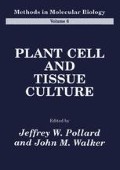Abstract
Isolated plant protoplasts can be induced to fuse with protoplasts from different species and, therefore, provide an ideal system for genetic modification and for use in plant breeding. Techniques for electrofusion of plant protoplasts have been developed relatively recently, and specialized apparatus is required, although this is now becoming more widely available. Electrofusion offers definite advantages over more commonly used protocols that make use of chemical stimulation to induce fusion. The most valuable aspects of electrofusion techniques are the high fusion frequencies attained, often tenfold higher than analogous chemical systems (1). The use of potentially toxic chemical stimulants is avoided, and the zones of membrane disturbance are limited to regions of membrane contact alone, all of which tends to preserve protoplast viability. Additionally, fusion events can be monitored microscopically, allowing the precise determination of the effects of various electrical parameters and, therefore, the use of optimum electrical values. Such control, together with manipulation of electrodes, allows more precise definition of parentage (2) than previously was possible with other methods.
Access this chapter
Tax calculation will be finalised at checkout
Purchases are for personal use only
References
Zachrisson, A. and Bornman, C. H. (1986) Application of electric field fusion in plant tissue culture. Physiologiu Plunfmwn 61, 314–320.
Koop, H. U. and Schweiger, H. G. (1985) Regeneration of plants after electrofusion of selected pairs of protoplasts. European Journal of Cell Biology 39, 46–49.
Murashige, T. and Skoog, F. (1962) A revised medium for rapid growth and bioassays with tobacco tissue culture. Physiologiu Plunturum 15, 473–487.
Scowcroft, W. R. and Larkin, P. J. (1980) Isolation, culture and plant regeneration from protoplasts from Nicotiuna debneyi. Australian Journal of Plant Physiology 7, 635–664.
Zimmermann, U. and Scheurich, P. (1981) High frequency fusion of plant protoplasts by electrical fields. Plunfu 151, 26–32.
Pilwat, G., Zimmermann, U., and Richter, H. P. (1981) Giant culture cells by electric field induced fusion. FEBS Letters 133, 169–174.
Author information
Authors and Affiliations
Editor information
Editors and Affiliations
Rights and permissions
Copyright information
© 1990 Humana Press Inc.
About this protocol
Cite this protocol
Donovan, A., Isaac, S., Collin, H.A. (1990). Electrofusion of Plant Cells. In: Pollard, J.W., Walker, J.M. (eds) Plant Cell and Tissue Culture. Methods in Molecular Biology™, vol 6. Humana Press. https://doi.org/10.1385/0-89603-161-6:373
Download citation
DOI: https://doi.org/10.1385/0-89603-161-6:373
Publisher Name: Humana Press
Print ISBN: 978-0-89603-161-6
Online ISBN: 978-1-59259-493-1
eBook Packages: Springer Protocols

